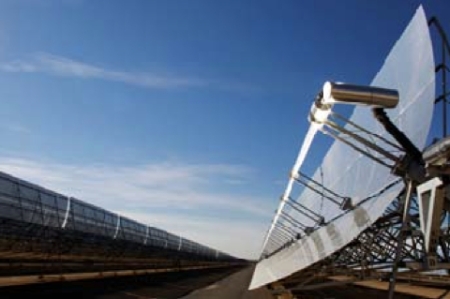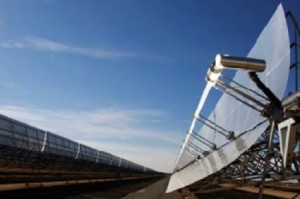Approval
Washington — U.S. Secretary of the Interior Ken Salazar recently announced the approval of four new projects on public lands, the launch of environmental reviews on three others, and the next step in a comprehensive environmental analysis to identify ‘solar energy zones’ on public lands in six western states.
New Projects
The four renewable energy projects include two utility-scale solar developments in California, a wind energy project in Oregon, and a transmission line in Southern California. Together, they will create more than 1,300 construction jobs and provide a combined 550 megawatts of electricity.

These projects include:
- Abengoa Mojave Solar Project. The 250-MW project will be located on 1,765 acres of private land in California, with 17 miles of transmission lines crossing public lands. The developer, Mojave Solar, LLC, has agreed to acquire more than 100 acres of habitat suitable for desert tortoise, Mohave ground squirrel and burrowing owl. The project will be constructed on previously disturbed, fallow agricultural land, thus avoiding impacts to pristine desert lands. The project will avoid an estimated 350,000 metric tons of carbon dioxide each year, according to the Department of Energy. The company estimates a construction payroll of $272 million and would spend about $121 million locally on materials and equipment.
- Imperial Solar Energy Center. The 200-MW project will be located on 946 acres of private land, with a 19-acre right-of-way on BLM land in Imperial County in California. The developer, CSOLAR Development, LLC, has agreed to acquire and enhance habitat for flat-tailed horned lizard and burrowing owls to compensate for project impacts. The project also will be constructed on previously disturbed, fallow agricultural land, thus avoiding impacts to pristine desert lands. CSOLAR will co-locate its transmission line on existing poles across much of the public land being crossed, minimizing impacts to less than 20 acres of permanent disturbance on public land. The project is expected to generate $38,000 to $80,000 in annual property taxes to Imperial County and an estimated $3 million in local sales tax revenue from the private land parts of the project.
- West Butte Wind Energy Project. Consisting of up to 52 wind turbines, each between 2 and 3 MW, on private land in Deschutes and Crook Counties, Ore., the project will produce up to 104 megawatts of electricity for homes and businesses. The project includes an access road and transmission line that would cross about 4.5 miles of BLM lands. BLM is requiring the developer, West Butte Wind Power LLC, to mitigate 9,000 acres of sage grouse habitat by providing funding for the restoration and enhancement of a similar amount and type of habitat on BLM lands. The company will also provide funds through Crook County to purchase conservation easements for sage grouse management and worked with the U.S. Fish and Wildlife Service to develop an avian (golden eagle) and bat protection plan and prepared a wildlife mitigation and monitoring plan for Crook County. The project will employ about 70 workers during construction with another 345 workers providing supplies, material, support and offsite services; and pay about $1 million annually to Crook County in property taxes.
- Devers-Palo Verde No. 2 Transmission Line Project. The 500 kV line will provide interconnection and electrical transmission for numerous solar energy facilities proposed for construction, including nine large-scale solar projects in California and Nevada with a potential output of more than 3,600 MW that were approved by Secretary Salazar last year. The developer, Southern California Edison, anticipates hiring about 200 construction workers for the project. The line will extend 115 miles from the Colorado River Substation near Blythe to the Devers Substation in Palm Springs and from the Devers Substation to the Valley Substation in Romoland, Riverside County, about 41.6 miles. The line will cross 57 miles of BLM land and two miles of San Bernardino National Forest land, running primarily along the I-10 Interstate, a primary corridor for energy transmission in Southern California. BLM is requiring conservation and design features to avoid and minimize potential adverse effects to the Kangaroo Rat, Milk-Vetch, Fringe-toed and Horned Lizard, and Desert Tortoise. The line will be constructed on previously disturbed, fallow agricultural land. The project has conducted extensive inventory, monitoring, site evaluation, awareness programs, consultation with Native Americans and other groups, and developed plans to protect cultural sites.
In addition, the Interior’s Bureau of Land Management has issued Notices of Intent to begin environmental analyses of two wind projects and a solar energy project located in California with a combined generating capacity of more than 370 megawatts.
Environmental Analysis
Salazar also announced that the Interior Department, in cooperation with the Department of Energy, will prepare a targeted supplement to the Draft Programmatic Environmental Impact Statement for Solar Energy Development (Solar PEIS). First released for public review in December 2010, the Solar PEIS will establish a framework for developing large utility-scale solar energy projects on public lands, based on landscape-level planning and the best available science, designed to promote the development in “solar energy zones” in Arizona, California, Colorado, Nevada, New Mexico, and Utah.
The supplement will address key issues identified through public comments and provide a number of enhancements, including developing well defined criteria for identifying solar energy zones; incentives for encouraging developers to site their projects in the zones and a variance process for those who wish to develop facilities outside such zones; additional surveys of biological and cultural resources in the zones; and a more detailed analysis of transmission.
No new solar energy zones will be analyzed in the supplemental document, but additional zones will be analyzed through other ongoing state and regional planning efforts, such as the California Desert Renewable Energy Conservation Plan, the West Chocolate Mountains planning effort in California, and the Arizona Restoration Design Energy Project.
Through the Solar PEIS supplement, Interior’s Bureau of Land Management would review the establishment of Solar Energy Zones within the lands available for solar development right of way applications. The six western states have been identified as most appropriate for development, containing the highest solar energy potential and fewest environmental and resource conflicts.

 Follow
Follow